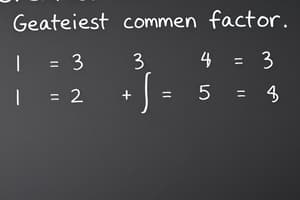Podcast
Questions and Answers
The greatest common factor of two numbers is always one of the numbers.
The greatest common factor of two numbers is always one of the numbers.
False (B)
What is the greatest common factor of 12 and 15?
What is the greatest common factor of 12 and 15?
3
The multiples of 5 are ___, 10, 15, 20,...
The multiples of 5 are ___, 10, 15, 20,...
5
How do you find the least common multiple of two numbers?
How do you find the least common multiple of two numbers?
A factor tree is a diagram that shows the prime factors of a number in a random order.
A factor tree is a diagram that shows the prime factors of a number in a random order.
What is the least common multiple of 8 and 12?
What is the least common multiple of 8 and 12?
To create a factor tree, start with the number and divide it by the ___________ prime factor.
To create a factor tree, start with the number and divide it by the ___________ prime factor.
Match the following concepts with their definitions:
Match the following concepts with their definitions:
Every positive integer can be expressed as a product of prime factors in a unique way.
Every positive integer can be expressed as a product of prime factors in a unique way.
Flashcards are hidden until you start studying
Study Notes
Prime Factors
- A prime factor is a prime number that divides a given number exactly without leaving a remainder.
- Every positive integer can be expressed as a product of prime factors in a unique way, known as the prime factorization.
- Prime factors are used to simplify fractions, find greatest common factors, and calculate least common multiples.
Greatest Common Factor (GCF)
- The greatest common factor (GCF) is the largest number that divides two or more numbers exactly without leaving a remainder.
- To find the GCF, list the prime factors of each number and identify the common prime factors.
- The GCF is the product of the common prime factors, each raised to the lowest power.
Multiples Patterns
- Multiples of a number are the products of that number and the counting numbers (1, 2, 3, ...).
- Multiples patterns can be used to identify relationships between numbers and to solve problems involving multiples.
- Examples of multiples patterns include:
- The multiples of 3 are 3, 6, 9, 12, ...
- The multiples of 4 are 4, 8, 12, 16, ...
Least Common Multiple (LCM)
- The least common multiple (LCM) is the smallest number that is a multiple of two or more numbers.
- To find the LCM, list the multiples of each number and identify the first multiple that appears in both lists.
- The LCM can also be found using prime factorization: list the prime factors of each number, and multiply the highest power of each prime factor that appears in both lists.
Factor Trees
- A factor tree is a diagram that shows the prime factors of a number.
- To create a factor tree, start with the number and divide it by the smallest prime factor.
- Continue dividing each factor by the smallest prime factor until only prime factors remain.
- The prime factors can be multiplied together to find the original number.
Prime Factors
- A prime factor is a prime number that divides a given number exactly without leaving a remainder.
- Every positive integer can be expressed as a product of prime factors in a unique way, known as the prime factorization.
- Prime factors are used to simplify fractions, find greatest common factors, and calculate least common multiples.
Greatest Common Factor (GCF)
- The GCF is the largest number that divides two or more numbers exactly without leaving a remainder.
- To find the GCF, list the prime factors of each number and identify the common prime factors.
- The GCF is the product of the common prime factors, each raised to the lowest power.
Multiples Patterns
- Multiples of a number are the products of that number and the counting numbers (1, 2, 3,...).
- Multiples patterns can be used to identify relationships between numbers and to solve problems involving multiples.
- Examples of multiples patterns include:
- The multiples of 3 are 3, 6, 9, 12,...
- The multiples of 4 are 4, 8, 12, 16,...
Least Common Multiple (LCM)
- The LCM is the smallest number that is a multiple of two or more numbers.
- To find the LCM, list the multiples of each number and identify the first multiple that appears in both lists.
- The LCM can also be found using prime factorization: list the prime factors of each number, and multiply the highest power of each prime factor that appears in both lists.
Factor Trees
- A factor tree is a diagram that shows the prime factors of a number.
- To create a factor tree, start with the number and divide it by the smallest prime factor.
- Continue dividing each factor by the smallest prime factor until only prime factors remain.
- The prime factors can be multiplied together to find the original number.
Studying That Suits You
Use AI to generate personalized quizzes and flashcards to suit your learning preferences.




